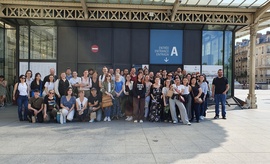The Crohn’s disease-related bacterial strain LF82 assembles biofilm-like communities to protect itself from phagolysosomal attack
AbstractPatients with Crohn’s disease exhibit abnormal colonization of the intestine by adherent invasive E. coli (AIEC). They adhere to epithelial cells, colonize them and survive inside macrophages. It appeared recently that AIEC LF82 adaptation to phagolysosomal stress involves a long lag phase in which many LF82 cells become antibiotic tolerant. Later during infection, they proliferate in vacuoles and form colonies harboring dozens of LF82 bacteria. In the present work, we investigated the mechanism sustaining this phase of growth. We found that intracellular LF82 produced an extrabacterial matrix that acts as a biofilm and controls the formation of LF82 intracellular bacterial communities (IBCs) for several days post infection. We revealed the crucial role played by the pathogenicity island encoding the yersiniabactin iron capture system to form IBCs and for optimal LF82 survival. These results illustrate that AIECs use original strategies to establish their replicative niche within macrophages.




